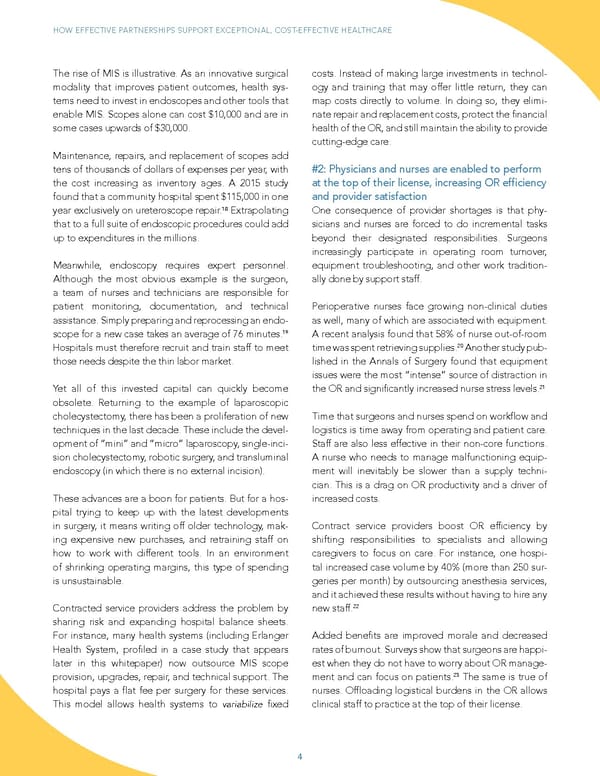HOW EFFECTIVE PARTNERSHIPS SUPPORT EXCEPTIONAL, COST-EFFECTIVE HEALTHCARE The rise of MIS is illustrative. As an innovative surgical costs. Instead of making large investments in technol- modality that improves patient outcomes, health sys- ogy and training that may offer little return, they can tems need to invest in endoscopes and other tools that map costs directly to volume. In doing so, they elimi- enable MIS. Scopes alone can cost $10,000 and are in nate repair and replacement costs, protect the financial some cases upwards of $30,000. health of the OR, and still maintain the ability to provide cutting-edge care. Maintenance, repairs, and replacement of scopes add tens of thousands of dollars of expenses per year, with #2: Physicians and nurses are enabled to perform the cost increasing as inventory ages. A 2015 study at the top of their license, increasing OR efficiency found that a community hospital spent $115,000 in one and provider satisfaction 18 year exclusively on ureteroscope repair. Extrapolating One consequence of provider shortages is that phy- that to a full suite of endoscopic procedures could add sicians and nurses are forced to do incremental tasks up to expenditures in the millions. beyond their designated responsibilities. Surgeons increasingly participate in operating room turnover, Meanwhile, endoscopy requires expert personnel. equipment troubleshooting, and other work tradition- Although the most obvious example is the surgeon, ally done by support staff. a team of nurses and technicians are responsible for patient monitoring, documentation, and technical Perioperative nurses face growing non-clinical duties assistance. Simply preparing and reprocessing an endo- as well, many of which are associated with equipment. 19 scope for a new case takes an average of 76 minutes. A recent analysis found that 58% of nurse out-of-room Hospitals must therefore recruit and train staff to meet time was spent retrieving supplies.20 Another study pub- those needs despite the thin labor market. lished in the Annals of Surgery found that equipment issues were the most “intense” source of distraction in 21 Yet all of this invested capital can quickly become the OR and significantly increased nurse stress levels. obsolete. Returning to the example of laparoscopic cholecystectomy, there has been a proliferation of new Time that surgeons and nurses spend on workflow and techniques in the last decade. These include the devel- logistics is time away from operating and patient care. opment of “mini” and “micro” laparoscopy, single-inci- Staff are also less effective in their non-core functions. sion cholecystectomy, robotic surgery, and transluminal A nurse who needs to manage malfunctioning equip- endoscopy (in which there is no external incision). ment will inevitably be slower than a supply techni- cian. This is a drag on OR productivity and a driver of These advances are a boon for patients. But for a hos- increased costs. pital trying to keep up with the latest developments in surgery, it means writing off older technology, mak- Contract service providers boost OR efficiency by ing expensive new purchases, and retraining staff on shifting responsibilities to specialists and allowing how to work with different tools. In an environment caregivers to focus on care. For instance, one hospi- of shrinking operating margins, this type of spending tal increased case volume by 40% (more than 250 sur- is unsustainable. geries per month) by outsourcing anesthesia services, and it achieved these results without having to hire any 22 Contracted service providers address the problem by new staff. sharing risk and expanding hospital balance sheets. For instance, many health systems (including Erlanger Added benefits are improved morale and decreased Health System, profiled in a case study that appears rates of burnout. Surveys show that surgeons are happi- later in this whitepaper) now outsource MIS scope est when they do not have to worry about OR manage- 23 provision, upgrades, repair, and technical support. The ment and can focus on patients. The same is true of hospital pays a flat fee per surgery for these services. nurses. Offloading logistical burdens in the OR allows This model allows health systems to variabilize fixed clinical staff to practice at the top of their license. 4
 Surgical Solutions White Paper Page 5 Page 7
Surgical Solutions White Paper Page 5 Page 7